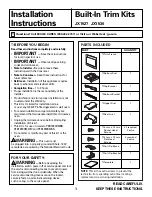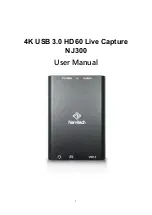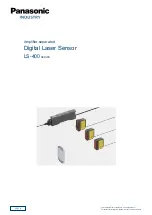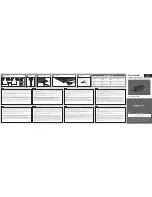
All information in this drawing is the property of The Watt Stopper Inc. and cannot
be copied or used without the written approval of The Watt Stopper Inc.
Drawn by: HUCKABONE
Sheet:
2
of
2
the
Watt Stopper Inc.
SANTA CLARA, CALIFORNIA
Title:
CI-12 Installation Instructions
Scale:
Drawing #
Original Drawing Date
Rev #
1 : 1
86-0467-00
16Jun95
3
DESCRIPTION
The CI-12 is a 12VDC Passive Infrared (PIR) occupancy sensor which inte-
grates with HVAC or EMS systems. The CI-12 provides isolated relay contacts
that are Normally Open or Normally Closed, based on occupancy.
PIR sensing systems are passive systems which react to changes in infrared
energy (moving body heat) within the coverage area. PIR sensors must directly
“see” motion of an occupant to detect them, so careful consideration must be
given to sensor placement.
COVERAGE PATTERNS
The CI-12 has a multi-cell, multi-tier Fresnel lens with a field of view of 360°.
The sensor has two lens pattern options. The Extended Range Lens will cover
up to 1200 sq ft and 22 feet from the sensor when mounted at 8 feet. The
High Density/Reduced Range Lens will cover up to 500 sq ft and 12 feet from
the sensor when mounted at 8 feet.
Coverage shown in the diagrams below is maximum and represents coverage
for half-step, walking motion, with no barriers or obstacles.
8 ft
22 ft
13 ft
7 ft 3 ft 0 3 ft 7 ft
13 ft
22 ft
Typical
desk-top
level
44 ft
DRAWING NOT TO SCALE
8 ft
12 ft
12 ft
3 ft
3 ft
5 ft
5 ft
7 ft
7 ft
9 ft
9 ft
0
Typical
desk-top
level
24 ft
Extended Range Lens (Standard)
CI-12
High Density/Reduced Range Lens
CI-12-1
PLACEMENT
The effective coverage distances may be slightly less than the maximum sens-
ing distance (see Coverage Patterns), depending upon obstacles such as fur-
niture or partitions, and this must be considered when planning the number of
sensors and their positioning. See the list below for approximate coverage dis-
tances for different types of motion.
Approximate coverage, for a mounting height of 8 feet:
Lens option
Walking motion
Workstation (hand motion)
Extended Range
up to 22 ft radius (1200 sq ft)
12 ft radius (500 sq ft)
High Density
up to 12 ft radius (500 sq ft)
9 ft radius (300 sq ft)
The CI-12 sensor can be mounted at various heights.
When you will be
mounting at heights other than 8 feet, be aware that as you decrease the
mounting height, you will decrease the range and increase the sensitivity to
smaller motions. Conversely, when you increase the height, you will increase
the range and decrease the sensitivity to smaller motions. At heights of more
than 12 -14 feet, you may start to significantly reduce sensitivity.
Often the best location to install a
CI-12 in a
closed office
is off-center
(see fig.1). Avoid placing a sensor
directly in line with an open door in
which it has a clear view out, as the
sensor may detect people walking by.
For
open office
areas with partitions it is
best to place sensors over intersections of
four workstations (see fig. 2).
Also avoid placing the sensors close to
air ducts
, as rapid air currents or the
differences in temperatures may cause
false activations. For large areas of
coverage use multiple sensors.
CI-12
36'
36'
CI-12
12'
18'
fig. 1
fig. 2
Check Our Web Site For FAQs: www.wattstopper.com
Check Our Web Site For FAQs: www.wattstopper.com
A 4-S junction box can be used with a 3" mud-ring when local building codes
mandate that low voltage connections be contained in a junction box.
Otherwise a 3" mud-ring or the provided ceiling attachment ring can be used.
IMPORTANT: If the lens will be masked
, the junction box or mud ring may
need to be positioned so that the mask is oriented properly when the sensor is
installed (see Masking).
Cut a hole in the ceiling tile
—if using a:
•
Ceiling attachment ring (provided)—cut about 2-3/4" to 3" in diameter.
•
3" mud ring—cut the hole to accommodate.
To assemble the sensor:
1. If using the ceiling attachment ring, bend the securing straps up so the sensor
housing can be inserted, and attach it to the sensor with the provided screws.
2. Attach the mask, if using, into the lens recess and onto the securing pins of
the cover.
3. Attach the cover to the rear housing—align tabs on inside of cover to
notches on outside perimeter of rear housing, place cover on sensor, and
twist clockwise to lock.
4. Insert the assembled sensor into the ceiling hole, and
if using the mask
,
turn the sensor so that the unmasked part of the lens is toward and centered on
the area to be covered.
5. Bend the ceiling attachment ring straps behind the hole to secure (or
attach sensor to mud ring with screws).
Ceiling
2-3/4" to 3" hole
(if using 3" mud-ring,
cut to accomodate)
Ceiling attachment ring
(bend behind ceiling
to secure)
Rear housing
Cover (with lens)
Mask secures
to pins on cover
Mask (optional)
cut for desired coverage
INSTALLATION
≠
CAUTION
≠
TURN POWER OFF AT CIRCUIT BREAKER BEFORE INSTALLING SENSOR
MASKING
An insert (mask) is supplied to allow elimination of coverage in unwanted areas.
The mask is cut as needed and mounted onto anchor pins in the sensor’s cover.
IMPORTANT: Do not use the mask if full coverage is desired.
IMPORTANT: Before securing the sensor
in the mounting location, the
assembled
sensor must be turned so the unmasked portion of the lens
faces the coverage area
(t
he blue masked area is visible through the lens)
.
IMPORTANT:
For an
already installed sensor
—If the sensor can NOT be turned,
then the mask must be cut so that when installed it will be oriented correctly
(note the
location of the securing pins
in the cover and note that the
cover
turns
as it locks into position).
Note:
At the edges of the masking, there is a small area of
reduced sensitivity
,
illustrated as the lighter area in the examples below.
Cut mask into sections
for desired coverage,
shown right.
Mask
Reduced sensitivity
Coverage area
WIRING DIRECTIONS
≠
CAUTION
≠
TURN POWER OFF AT CIRCUIT BREAKER BEFORE WIRING SENSOR
•
C12VDC Supply to the RED and Return to the BLACK wire from
the sensor.
Isolated Relay:
(Rated for 1A @24VDC or 24VAC)
Connect the wires necessary to the application that requires this output.
•
GREEN (
Normally Closed
)—Open when occupancy is detected
•
ORANGE (
Common
) (must be used for proper operation)
•
YELLOW (
Normally Open
)—Closed when occupancy is detected
✆
Call 1(800)879-8585 For Technical Support
✆
✆
Call 1(800)879-8585 For Technical Support
✆
+12VDC,
+2V/-0.5V
RED
Wires
12VDC Return
BLACK
Isolated Relay Outputs
Normally Closed Contact
GREEN
Common
ORANGE
Normally Open Contact
YELLOW
CI-12
Sensor






















